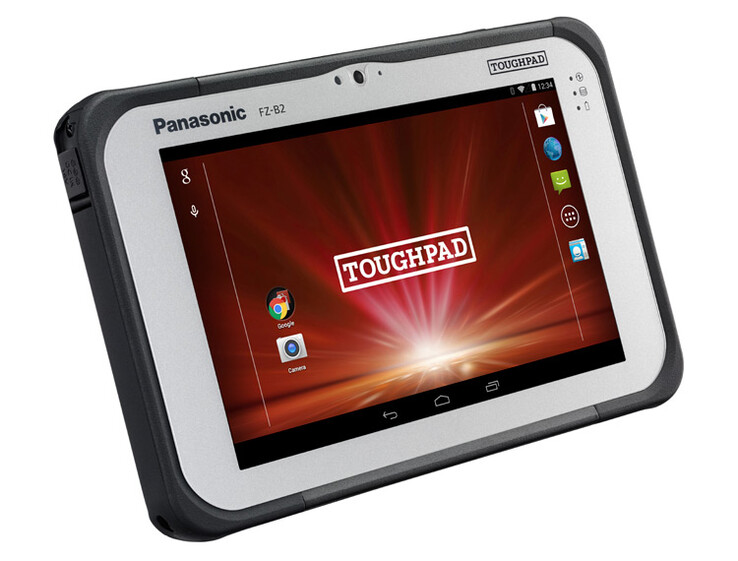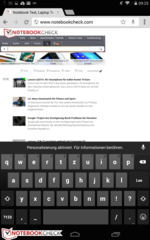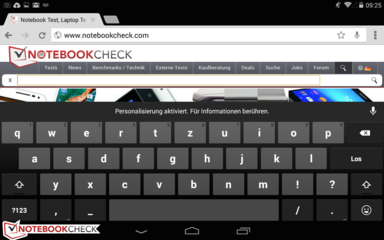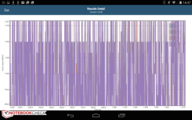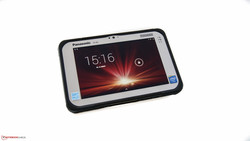Panasonic Toughpad FZ-B2 Tablet Review

For the original German review, see here.
More than just strong inner values are needed to withstand the industrial workday. Instead, it is necessary to fulfill a certain quality standard in terms of build and stability. Panasonic's Toughpad FZ lineups are to meet these demands. We are dealing with a fully ruggedized, 7-inch Android tablet powered by an Intel processor and 2 GB of working memory. We have examined the business line before. Not long ago we tested the Windows version, which only looks slightly different. The price for our model ranges from 1000 to 1600 Euros (~$1129 to $1807), depending on the included accessories. Equally robust contenders can also be found among the competition. For example Samsung's Galaxy Tab Active that is available for 500 Euros (~$565). HP's Pro Slate 8 also proved to be a worthy business rival in our test. The review sample was sold for 600 Euros (~$678). The one-inch bigger Sony sports 3 GB of working memory. Buyers do not have to dig particularly deep in their pockets at a price of approximately 480 Euros (~$542) here, either.
Case
The first contact with Panasonic's FZ-B2 already conveys the rugged character of the tablet. We find many edges and imperfections in the haptics. HP uses a completely different approach for its HP Pro Slate 8, which has a good-looking, sleek design. On the other hand, Panasonic guaranties that our review sample will endure drops from a height of 180 cm (~6 feet) without being damaged. Furthermore, the casing is dustproof and waterproof in compliance with the IP65 protection class. Sony's Xperia Z3 also has this IP certification. Our review sample features a barcode scanner, and thus its weight climbs from 540 to 590 grams (from ~19 to 21 oz). The extra module juts out of the back by approximately 0.7 mm (~0.03 in), and increases the height of the FZ-B2 to 2.7 cm (~0.1 in). Panasonic's tablet is already twice as tall as the named rivals even without the barcode scanner.
Other modules can be connected separately by releasing only six screws. Another highlight is that the battery is hot-swappable, and the device does not have to be shut down for its exchange. The option is available via the expansion module.
Connectivity
Intel's Celeron N2930 provides our 7-inch tablet with computing power. The CPU has a base clock of 1.83 GHz, which drops to around 500 MHz in idle mode. The manufacturer specifies a TDP of 7.5 watts. The quad-core processor is also found in Windows tablets and small laptops. Panasonic, however, relies on a considerably stronger Intel Core i5 processor for its Windows lineup. Qualcomm modules are found in the competition. The GPU is the processor-integrated graphics card. Intel's HD Graphics (Bay Trail) is located in the upper mid-range in the tablet sector.
As to the interfaces, the power socket, USB 3.0 port, and headset jack are fitted with a protective flap. It is not possible to connect wider and bigger flash drives without hassle. It might be necessary to use an extension cord because the USB port is set a bit deeper in the device. Connectors for the port replicator and antenna are located on the lower edge. The device also has fixtures in the corners for diverse holders.
Software
Android 4.4 KitKat is preloaded ex-factory. An update to the latest Android 5.0 Lollipop is available. The manufacturer does not offer special software from the outset.
Communication & GPS
Unlike the Windows version of our review sample, only Wi-Fi is available for determining location. A GPS option is not offered, although a GPS receiver is allegedly possible according to the specifications of the integrated Gobi 5000 module. We cannot verify that, though. Should GPS tracking be compulsory, the buyer will have to fall back on Panasonic's FZ-M1 or a contending model such as Samsung's Galaxy Tab Active or Sony's Xperia Z3. HP's Pro Slate 8 does not feature a GPS receiver, either.
Intel's Dual Band Wireless-AC 7260 module sets up wireless connections. According to the manufacturer, transmission speeds of up to 867 MBit/s are possible. We had to move approximately 7 meters (~23 feet) away from the router before losing the first bar of the Wi-Fi signal, which involved overcoming one story and two walls. An extension can be connected via the dual antenna connector to ensure a stable connection.
A Gobi 5000 module is installed for mobile use. The micro-SIM for the mobile 4G broadband is found in the battery compartment. A maximum downstream speed of 42 MBit/s is possible via HSPA+. The equally supported LTE standard makes up to 100 MBit/s possible.
Cameras & Multimedia
Panasonic treats its FZ-B2 to a 5 MP rear-facing camera and a 2 MP front-facing camera. The unit on the rear additionally features auto focus and LED flash. Unfortunately, we have to criticize some points about this camera. Firstly, the photo is extremely delayed, and an intense image noise is produced when the light conditions worsen. Furthermore, the shutter lag is very long. Although the front-facing camera is far from high quality, its reproduction is smoother and its release time is faster. The rear-facing camera only records videos at 15 fps, and the front-facing camera at a fluid 30 frames per second.
Now a look at a real-world utilization. Our model also features a barcode scanner, which can be enabled by pressing a button on the device's upper edge. Besides the laser itself, a bright LED is also activated for illumination. Identifying various test codes functioned extremely fast and precisely. The laser worked accurately even in difficult cases, such as on a crumpled or glossy surface. The scanner also performs other actions depending on the app. For example, the camera shoots a photo when scanning succeeded in a turned off state. The barcode is then copied in a text program, and a folder with the barcode is added in the file manager.
Accessories
Panasonic shipped our Toughpad model with a strap and a microfiber cloth. A variety of other accessories can be found on the manufacturer's site. For example, a larger 4-cell battery might be interesting. A station matching the docking port also exists. A capacitive stylus, various power adapters, bags and holders are only some articles. Panasonic does not state any exact prices on its accessories page.
Warranty
Pleasingly, customers receive a 3-year warranty when buying the Panasonic FZ-B2. Three-month accidental damage coverage is additionally activated when the device is registered. Other, lower priced rivals like Sony's Xperia Z3 only allow a 24-month warranty.
Input Devices & Handling
A 5-point multi-touchscreen makes finger inputs possible. The capacitive screen is highly responsive and accurate. Particularly significant for industrial use is the glove mode. A stylus is optionally available. The buttons on the upper edge are quite close to each other, which makes them difficult to use with thicker work gloves. The power button has a separate rim, making it discernible from the others. The keys' drop is set ideally, and is not too long.
Display
A matte IPS screen with a resolution of 1280x800 pixels is installed in the Toughpad FZ-B2. HP opts for a higher resolution and glossy panel for its Pro Slate 8. This alternative might thwart use depending on where it is used. Panasonic states a maximum brightness of 800 cd/m². Unfortunately, we cannot confirm this rate. The average is approximately 500 cd/m². We could not achieve a higher brightness even in a direct light source. Fortunately, the brightness does not decrease in battery mode. With the exception of Sony's Xperia Z3, our selected contenders do not reach these brightness levels. Sony's tablet is a touch brighter with 518 cd/m². We noticed that the brightness fluctuated strongly in our case. The analysis sometimes led to a maximum brightness of just 330 cd/m².
| |||||||||||||||||||||||||
Brightness Distribution: 85 %
Center on Battery: 540 cd/m²
Contrast: 1688:1 (Black: 0.32 cd/m²)
ΔE ColorChecker Calman: 23.34 | ∀{0.5-29.43 Ø4.78}
ΔE Greyscale Calman: 6.82 | ∀{0.09-98 Ø5}
Gamma: 2.21
CCT: 6334 K
| Panasonic Toughpad FZ-B2 HD Graphics (Bay Trail), N2930 | HP Pro Slate 8 Adreno 330, 800 MSM8974, 16 GB eMMC Flash | Samsung Galaxy Tab Active Adreno 305, 400 MSM8926, 16 GB eMMC Flash | Sony Xperia Z3 Tablet Compact Adreno 330, 801 MSM8974AC, 16 GB eMMC Flash | |
|---|---|---|---|---|
| Screen | 3% | -18% | -11% | |
| Brightness middle (cd/m²) | 540 | 416 -23% | 424 -21% | 531 -2% |
| Brightness (cd/m²) | 498 | 388 -22% | 426 -14% | 518 4% |
| Brightness Distribution (%) | 85 | 86 1% | 85 0% | 91 7% |
| Black Level * (cd/m²) | 0.32 | 0.41 -28% | 0.7 -119% | 0.66 -106% |
| Contrast (:1) | 1688 | 1015 -40% | 606 -64% | 805 -52% |
| Colorchecker dE 2000 * | 23.34 | 3.7 84% | 5.7 76% | 6.29 73% |
| Greyscale dE 2000 * | 6.82 | 3.46 49% | 5.76 16% | 7.04 -3% |
| Gamma | 2.21 100% | 2.4 92% | 2.36 93% | 2.78 79% |
| CCT | 6334 103% | 6629 98% | 7236 90% | 8600 76% |
| Color Space (Percent of AdobeRGB 1998) (%) | 73.75 |
* ... smaller is better
We recorded a black level of 0.32 cd/m². That ensures a sufficiently rich black. The resulting contrast of almost 1700:1 was noticed very favorably. Black sequences also made a saturated impression seen just subjectively.
The CalMAN analysis delivered strongly varying rates. The shift of the black rates had a DeltaE rate of 6.82. That outcome is a poor mean considering a high-quality IPS screen is installed. The DeltaE shift of 23.34 in the colors is even more dismaying. For comparison, the rate of HP's Pro Slate 8 is 3.7. We could not identify the reasons for this insufficient result.
Thanks to the matte IPS screen, the Toughpad is suitable for outdoor use. Direct sunlight could, however, thwart use anyway. The tablet's viewing angle stability makes a good impression. Neither colors nor brightness distort in different positions.
Performance
Just subjectively, the Android tablet makes a swift impression. As hinted earlier, Panasonic relies on performance components from Intel. Intel's Celeron N2930 that clocks at up to 1.8 GHz does not feature a Turbo mode. The analysis of the processor's performance using Geekbench shows that our review sample places itself in front of Samsung's Galaxy Tab Active, but 18% behind our reviewed Sony Xperia Z3.
We use GFXBench 3.0 to measure the pure GPU speed. It proves the superiority of the internal Intel HD Graphics. The selected contenders are far behind our review sample in the onscreen test. A powerful Tegra K1 Kepler graphics unit would be needed to top the performance. HP's tablet is on par with the FZ-B2 in the offscreen test.
The performance when the CPU, GPU and storage option are interacting simultaneously is interesting. We opted for the AnTuTu procedure as the benchmark. Again, the Galaxy Tab Active is no match for either our model or HP's device. The FZ-B2 and Pro Slate 8 are almost on par.
The tide turns in storage speed. Our review sample has to be satisfied with last place in the comparison field. Panasonic's device lags behind HP's Pro Slate 8 by roughly 25% with approximately 148 MB/s.
Finally, we will look at the outcome in the browser benchmarks. Our review sample shows signs of weakness in Sunspider and Octane compared with Samsung's comparison device.
| AnTuTu v5 - Total Score (sort by value) | |
| Panasonic Toughpad FZ-B2 | |
| Samsung Galaxy Tab Active | |
| HP Pro Slate 8 | |
| Sony Xperia Z3 Tablet Compact | |
| LG G Pad 8.0 V480 | |
| Google Nexus 9 | |
| Sunspider - 1.0 Total Score (sort by value) | |
| Panasonic Toughpad FZ-B2 | |
| Samsung Galaxy Tab Active | |
| Sony Xperia Z3 Tablet Compact | |
| LG G Pad 8.0 V480 | |
| Google Nexus 9 | |
| Octane V2 - Total Score (sort by value) | |
| Panasonic Toughpad FZ-B2 | |
| Samsung Galaxy Tab Active | |
| Sony Xperia Z3 Tablet Compact | |
| Samsung Galaxy Tab Pro 8.4 | |
| LG G Pad 8.0 V480 | |
| Google Nexus 9 | |
| Mozilla Kraken 1.1 - Total (sort by value) | |
| Panasonic Toughpad FZ-B2 | |
| Samsung Galaxy Tab Active | |
| Sony Xperia Z3 Tablet Compact | |
| Samsung Galaxy Tab Pro 8.4 | |
| LG G Pad 8.0 V480 | |
| Google Nexus 9 | |
* ... smaller is better
Games
Although the GPU performance could prove itself in the benchmarks, it was not enough for a solid frame rate in the game "Asphalt 8" despite the fact that the maximum resolution was limited to 1280x800 pixels. Smaller games, such as "Angry Birds 2" always made a lag-free impression.
Emissions
Temperature
Panasonic relies on a fan-less design. We measured temperatures of up to 36 °C (96.8 °F) in idle mode, and they climbed up to 39.3 °C (102.74 °F) in a load scenario. We tested this at a room temperature of approximately 22 °C (71.6 °F). The device also got palpably warm after prolonged normal use. The reached temperatures are not at all disconcerting as long as industrial use does not have to be considered. These rates could definitely be higher in a warmer industrial environment. What consequences that will have cannot be said here. The comparison device from Samsung remains considerably cooler with a maximum rate of 34 °C (93.2 °F).
We observed the clock frequencies inside in a stress scenario via the Stability Test app. The CPU maintained its base clock of 1.83 GHz for a long time after starting the GPU and CPU test. The frequency varied increasingly within the first half an hour. This clock behavior was also seen in Geekbench's battery test (screenshot). The clock rate dropped gradually after about 40 minutes. The review sample only clocked at 500 MHz after 54 minutes. BaseMark OS II only achieved half as many points as after a cold start subsequent to the test.
(+) The maximum temperature on the upper side is 39.3 °C / 103 F, compared to the average of 33.7 °C / 93 F, ranging from 20.7 to 53.2 °C for the class Tablet.
(+) The bottom heats up to a maximum of 39.2 °C / 103 F, compared to the average of 33.2 °C / 92 F
(±) In idle usage, the average temperature for the upper side is 32.6 °C / 91 F, compared to the device average of 30 °C / 86 F.
Speaker
The system sounds are loud and dominant. The installed speaker is not suitable for music playback. Songs sound muffled and distorted. That is possibly due to the casing's sealing that is to prevent dust and water from penetrating. Therefore, external peripherals should be used for audio entertainment.
Energy Management
Power Consumption
We measured an idle power consumption of 3.7 - 4.3 watts, which is considerably higher than Samsung's Galaxy Tab Active with 0.6 - 2.5 watts. The standby consumption of 2.5 watts is also relatively high. Consequently, the battery's capacity of 100% dropped to 26% after 8 hours of standby. The capacity dropped to just 11% after 10 hours when the communication modules were disabled. Our review sample consumed between 6.9 and 9.3 watts maximum. Samsung's tablet only demands half of that. On the other hand, HP's Pro Slate 8 can near the 10-watt mark in some cases.
The included power supply can more than meet the demands of the FZ-B2. The power supply has a specified output of up to 60 watts.
| Panasonic Toughpad FZ-B2 HD Graphics (Bay Trail), N2930 | HP Pro Slate 8 Adreno 330, 800 MSM8974, 16 GB eMMC Flash | Samsung Galaxy Tab Active Adreno 305, 400 MSM8926, 16 GB eMMC Flash | Sony Xperia Z3 Tablet Compact Adreno 330, 801 MSM8974AC, 16 GB eMMC Flash | |
|---|---|---|---|---|
| Power Consumption | 27% | 55% | 45% | |
| Idle Minimum * (Watt) | 3.7 | 0.7 81% | 0.6 84% | 0.6 84% |
| Idle Average * (Watt) | 4.2 | 3 29% | 2.2 48% | 2.9 31% |
| Idle Maximum * (Watt) | 4.3 | 3.2 26% | 2.5 42% | 3.1 28% |
| Load Average * (Watt) | 6.9 | 6.2 10% | 3.7 46% | 4.4 36% |
| Load Maximum * (Watt) | 9.3 | 10.2 -10% | 4.3 54% | 4.9 47% |
* ... smaller is better
| Off / Standby | |
| Idle | |
| Load |
|
Key:
min: | |
Battery Runtime
A 2-cell battery with a capacity of 23.9 Wh is installed in our model of the FZ-B2. The manufacturer states that it should achieve a runtime of up to seven hours.
We ascertain a real-world runtime for mobile use by simulating Internet browsing. Panasonic's tablet shut down after 5 hours using a brightness of 150 cd/m². Our review sample apparently cannot compete with the runtimes of the tablets from HP and Samsung. However, we would like to mention the optional, larger battery and the battery's hot swap feature again.
| Panasonic Toughpad FZ-B2 HD Graphics (Bay Trail), N2930 | HP Pro Slate 8 Adreno 330, 800 MSM8974, 16 GB eMMC Flash | Samsung Galaxy Tab Active Adreno 305, 400 MSM8926, 16 GB eMMC Flash | Sony Xperia Z3 Tablet Compact Adreno 330, 801 MSM8974AC, 16 GB eMMC Flash | |
|---|---|---|---|---|
| Battery runtime | 104% | |||
| WiFi v1.3 (h) | 5 | 10.2 104% | ||
| Load (h) | 4 | 5.1 | 5.2 | |
| H.264 (h) | 12.9 | 14.5 | ||
| WiFi (h) | 14.4 | 14 |
Pros
Cons
Verdict
Panasonic has presented us with a thoroughly rugged business tablet. We tip our hats in terms of stability and the casing's specifications. Unfortunately, some drawbacks had to be accepted in the course of the test. The photo quality of both integrated cameras is rather poor. Particularly the release time of the rear-facing camera is very long. In return, the accurate barcode scanner can score. As to the screen, the high contrast is compelling, but the brightness fluctuates and does not comply with the manufacturer's promise. Apart from that, the system feels swift and balanced. One noteworthy shortcoming is, however, throttling that even occurs during load at normal room temperature. Panasonic has a variety of modular expansions, such as a better camera or a bigger battery. The weak rear-facing camera in our model was a thorn in our side - primarily due to the long shutter lag. The price ranges from 1000 to 1600 Euros (~$1129 to $1807) depending on the basic configuration.
In total, the FZ-B2 is a true business partner that does not falter even in tough usage scenarios.
However, HP's Pro Slate 8 will serve well should the total package not be needed and more value is placed on design. Samsung's Galaxy Tab Active also presents itself as a welcome industrial partner thanks to its long battery life and solid build. Risking a glance at the FZ-M1 might be worthwhile if it is to be the FZ-B2, but a Windows-based operating system is preferred.
Panasonic Toughpad FZ-B2
- 08/20/2015 v4 (old)
Nino Ricchizzi




